
|
Teacher's Study Guide for Lesson Four
by Dr Jamie Love |
 |
 and
and  licensed under a Creative Commons Attribution-ShareAlike 4.0 International License.
licensed under a Creative Commons Attribution-ShareAlike 4.0 International License.

|
Teacher's Study Guide for Lesson Four
by Dr Jamie Love |
 |
"Normal" cells contain two full sets
of chromosomes and are described as diploid.
Abbreviated as 2n to remind us that it is a "double"
set.
Most of your cells are diploid - they contain two sets of chromosomes.
Each set of human chromosomes contains 23 chromosomes
so most cells in your body have 46 chromosomes.
Mature gametes, the sex cells (sperm and egg) have only one full
set of chromosomes. Cells with only one set of chromosomes are
called haploid. ("Haploeides" is Greek for "single".)
Abbreviated as 1n to remind us there's only one set of
chromosomes.
Ploidy, the number of chromosomes in a cell, is very important
in genetics and in understanding genetics, so keep track of the
chromosome numbers.
When a diploid cell (2n) undergoes mitosis and cytokinesis it
produces two diploid cells (each also of 2n).
|
Mitosis is often called "copy division" because the genetic material is copied.
(What would happen if gametes were diploid (2n)?)
|

|
During meiosis and the cytokinesis that follow, one diploid mother cell (2n) makes four unique daughter cells and they are all haploid (1n)!
| Meiosis is often called "reduction division" because the genetic material is reduced (by half). |

|
Sexual reproduction combines the genetic information from
two different cells (usually from two different individuals).
Each parent contributes a haploid (n) gamete (sex cell).
These two gametes, a female egg and a male sperm, fuse to produce
a genetically unique single cell called a zygote. The zygote
is diploid (2n) it is "half identical" to each parent.
|
Meiosis reduces the genetic material in half and fertilization
creates a unique individual from the fusion of those two halves
of genetic material.
When that individual undergoes meiosis his (or her) sperm (or egg) will NOT be a recreation of its father's sperm or mother's egg. An individual will produce unique gametes containing a quarter of dad's genes and a quarter of mom's genes for a total of a half-filled gamete (haploid - n). That unique gamete will fuse with another (haploid) gamete from elsewhere and that fusion will create another unique zygote that will grow into a unique individual. That new individual will be composed of the genetic materials from…. ¼ of mom's mom ¼ of mom's dad ¼ of dad's mom ¼ of dad's dad |
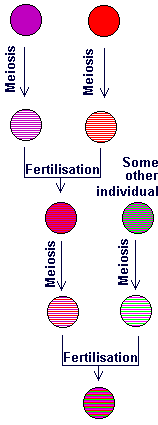
|
Chromosomes must be distributed in a concise manner to make sure that a full set (n) of chromosomes is in the gametes. So, meiosis
|
A diploid cell (2n) is composed of a set (n) from both
parents and they can be thought of as pairs of chromosomes.
The chromosomes from your father are called paternal (and can be abbreviated as "P") and those from your mother are called maternal (abbreviated as "M"). [I remember this as "Pop and Mom".]
These pairs are called homologous pairs (of chromosomes).
|
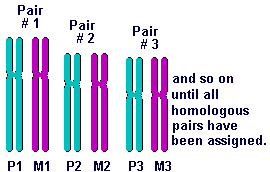
|
|
When the two homologous pairs are aligned (side by side) we call
the pair a tetrad.
Therefore, a tetrad is composed of two chromosomes - one maternal (M) and one paternal (P). A tetrad will have two centromeres and four chromatids (because it is made from two chromosomes). Recall that a dyad was a single (X-shaped) chromosome so a tetrad is composed of two dyads. |

|
Meiosis is different from mitosis because there are two divisions
and the chromosomes line up differently at the two different metaphase
plates. (As tetrads in the first division and as dyads in the second division.)
We add a I (one) or II (two) to the end of each phase to remind us which division of meiosis we are talking about.
Prophase I looks identical to mitotic prophase but the chromosomes are matched up in homologous pairs and they swap genetic material between themselves!
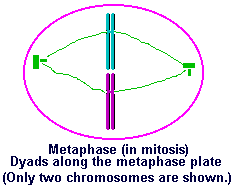
|
In metaphase I (of meiosis I ) tetrads are aligned along
the metaphase plate!
Notice that the M and P pairs in the tetrad can be aligned to either side. Using a human cell as an example, a mitosis metaphase will show 46 dyads (chromosomes) along the metaphase plate but in metaphase I (of meiosis I) the metaphase plate contains 23 tetrads. |
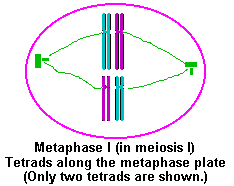
|
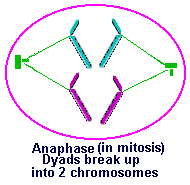
|
In anaphase I (of meiosis I) each tetrad separates into
two dyads. The paternal and maternal partners are separated. Anaphase
I is the point at which the reduction division occurs!
Notice that each pair is separated in a random direction. |
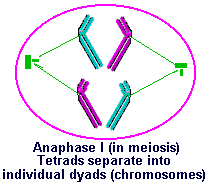
|
After anaphase I comes telophase I and the two newly formed (daughter) nuclei will be haploid (contain n chromosomes). So, after cytokinesis we have two daughter cells that are haploid (and very different from each other - they will be "opposite pairs"!).
The second division follows without interphase or S phase so there is no duplication of genetic materials. Both daughter cells enter meiosis II as haploid cells. The centrosomes are duplicated.
Meiosis II is identical to mitosis except now there will be only half as many chromosomes to deal with.
Both of the daughter cells produced from the cytokinesis (which
occurred after meiosis I) will go through meiosis II together.
In Prophase II the spindle fibers connect to the chromosomes but this time they grab the chromosomes from both sides (using both kinetochores) and prometaphase II is like prometaphase of mitosis (but with half as many chromosomes).
|
Metaphase II and anaphase II are identical to metaphase and anaphase
in of mitosis (except there are half as many chromosomes).
At metaphase II the chromosomes line up along the metaphase plate (as a string of dyads). At anaphase II the chromosomes are pulled apart into separate chromatids (which are now chromosomes). Anaphase II is followed by telophase II at which point the chromosomes are bundled into two (haploid) nuclei, one at each pole. Then cytokinesis occurs and the cell divides its two haploid nuclei between the two new cells. The end result is two cells each with a haploid nucleus. |
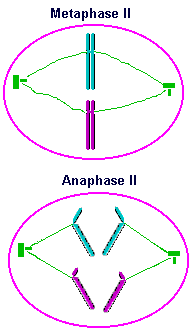
|
